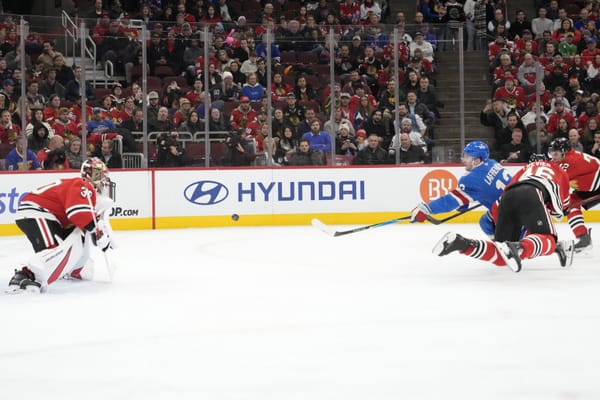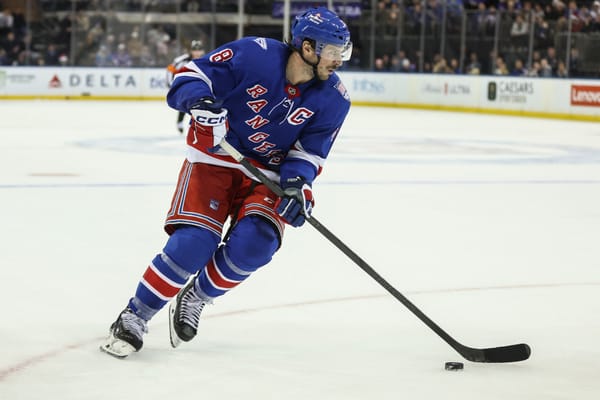Analyzing the Early Returns on the Rangers’ Trade Deadline Acquisitions
So far, it looks like Chris Drury pushed all the right buttons at the trade deadline.
The New York Rangers, from a win-loss standpoint, have undoubtedly exceeded any realistic expectations for this season. That success, combined with plentiful but highly temporary salary cap space and the need to “go for it” while Chris Kreider and Igor Shesterkin are having historic campaigns, led to general manager Chris Drury doing the right thing and adding difference-makers ahead of the March 21 trade deadline.
Drury acquired several forwards to help the team’s depth: Andrew Copp, Frank Vatrano, and Tyler Motte. The Rangers also added defenseman Justin Braun for blue-line depth. Drury managed to pick up these players while not parting with any lineup regulars, top prospects — with all due respect to Morgan Barron — or first-round draft picks (unless Copp plays in 50 percent of the Rangers playoff games AND the Rangers make the conference finals, which would be a good thing and also result in a lower pick). All — particularly the forwards — have helped the Blueshirts form a deeper and more well-rounded attack, providing excellent early returns that have made Drury look quite shrewd and almost erased doubts that were paramount following the offseason trade of Pavel Buchnevich. (OK, maybe not so much on that last part.)
Better Underlying Play
Strong goaltending, special teams, and game-breaking talent at the top of the lineup have propelled the Rangers’ success this year. Of course, as has been well documented, their five-on-five play has left much to be desired for most of the season.
While underwhelming five-on-five play is a macro issue in nature that has been the result of multiple factors, a key weakness for the Rangers that seemed to be exacerbating their even-strength struggles was a noticeable lack of forward depth, particularly in the wake of long-term injuries to Sammy Blais, Kaapo Kakko, and Kevin Rooney. Players like Greg McKegg, Julien Gauthier, Dryden Hunt, and Tim Gettinger, among others, have all been leaned on at various points throughout this season to elevate their roles beyond what should reasonably be expected of them. The result has been a top-heavy lineup with an often-punchless bottom-six.
Enter Copp, Vatrano, and Motte. All three players address these depth issues and allow others to slot into more appropriate roles — whether that’s lower in the lineup or, with all due respect, in the press box or AHL.
The positive effect of this trio is noticeable at the team level. Beyond the Rangers’ 5-2-1 record since all three players have been a part of the roster, their five-on-five play — previously a glaring weakness — has taken a noticeable turn in the right direction. Strong evidence of this exists when looking at their share of expected goals (xGF%) at five-on-five play. Put simply, this measure helps distill how well a team generates scoring chances in terms of both quality and quantity, and how well it prevents scoring chances against.
Per Natural Stat Trick (and as of league results through April 5), the Rangers sit at 26th in the league in xGF% at five-on-five play, with a rate of just 46.85 percent for the season. That is, to be blunt, not good! But breaking this measure into the pre- and post-trade deadline results paints a different picture.
Prior to March 21, which encompassed 63 games for the Rangers, their five-on-five xGF% was 45.47 percent, which ranked 28th in the league. In the eight games they have played with their full complement of new acquisitions, that figure has jumped up to a robust 58.09 percent — good for third in the NHL over that same span, behind only the Boston Bruins and the Florida Panthers. Yes, it’s a small sample, and one that includes some weaker competition, but the Rangers’ improved five-on-five play is nonetheless extremely encouraging, as it correlates to the deeper lineups they have been able to dress since March 21.
Strong Individual Results
From an individual standpoint, Copp and Vatrano have provided the most noticeable immediate dividends. Copp has tallied three goals and six assists in his eight games with the Rangers, forming some budding chemistry on the second line with Artemiy Panarin along the way. The Rangers’ five-on-five xGF% with Copp on the ice is an astounding 65.28 percent. He is exactly the type of play-driving, middle-six forward the Rangers had been missing all season.
Vatrano, meanwhile, came over to the Rangers almost a week ahead of deadline day, on March 16. On a team that skews pass-happy, Vatrano has provided a much-needed shoot-first mentality, which has helped him score five goals (along with two assists) in 11 games as a Ranger. He has seen consistent time of late on the top line with Kreider and Mika Zibanejad, as head coach Gerard Gallant now has a bevy of viable line combination options at his disposal.
Motte has yet to find the score sheet since coming to New York, but that does not diminish the positive effect he’s had as a speedy, disruptive player on the fourth line — which is exactly what the Rangers wanted from him when they acquired him. In addition to his strong penalty-killing abilities, Motte’s individual five-on-five xGF% mark stands at a very strong 56.84 percent.
Forwards were the main area of need for the Rangers going into the trade deadline, but Drury’s acquisition of Braun, a right-handed defenseman, nevertheless gives the Rangers some insurance on the blue line. Braun has only played in three of the eight games since joining the Rangers, but the positive is that Gallant has options for the bottom pair between Braun, Patrik Nemeth, and solid rookie Braden Schneider — not to mention, of course, depth in the event of an injury.
As Kaapo Kakko and Kevin Rooney inch closer towards returning from injuries, the Rangers find themselves with a good problem of having too many forwards. They have a number of lineup options, and any of them will be better than what they have had to dress for most of the season. Drury might not have added a marquee name to the mix, but he has made a big difference simply by replacing the team’s most ineffective players with better ones.





